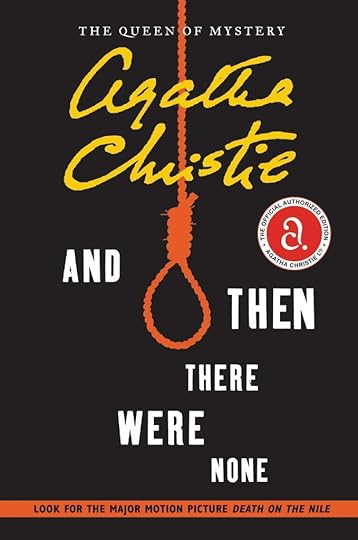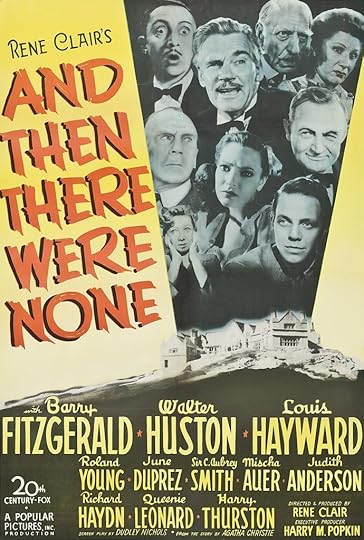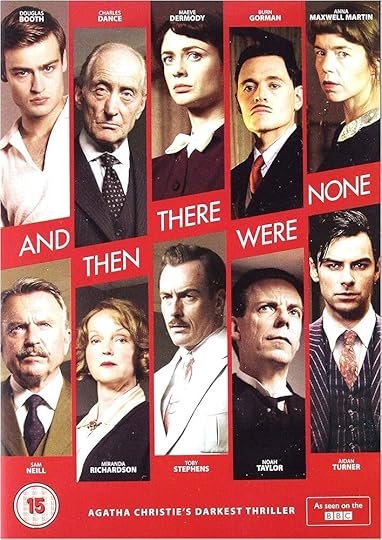Book Review: And Then There Were None

Do I need to give a synopsis for And Then There Were None by Agatha Christie? It’s a classic. Well, I will anyhow.
Ten people across England get an alluring message from a Mr. and Mrs. Owen asking them to come to an isolated island off the coast of Devon. After they arrive, a disembodied voice recites a guilty secret for each of them. By the time dinner is over, one of them is dead and they realize they are all next, one by one. With a storm cutting them off from any help they might have received, they have to figure out who is killing them before they all wind up dead.
In other words, it’s a classic set-up. But it’s a classic set-up partly because Agatha Christie made it a classic. And this is one of her most quintessential books. (Did you know that after the Bible and Shakespeare, Christie is the most published author? It says that like three times on my copy of the book.) Which is why my beta readers for my YA supernatural mystery gave me the homework of reading And Then There Were None, a book I have meant to read for years. (They also gave me the homework of making a chart for my suspects and clues. Well, and ripping apart and rebuilding my book.)
Yeah, I liked the book. It was fun to read. It was clear and clean and I always wanted to pick it back up because whodunnit?. And Then There Were None is a mystery and Agatha Christie writes world-famous mysteries. However, this book is almost an exception: it is also horror/psychological horror. It has elements of every slasher film that would come after it. And it is also a trip into Vera’s mind and a book about guilt and justice.
The story is brisk. The writing is high and tight. The thoughts, words, perspectives, swirl yet are almost poetic in the sparseness. Nearly every sentence serves a quick purpose and a long one. At times I was annoyed that there were so many perspectives (eight to ten of them, some leaned on much more heavily than others), but at other times it was fun, and I was both needled and electrified (no puns intended) by the times I might be in the killer’s head (but didn’t know it! If I’m not mistaken, there were two to three sentences in the book that were thoughts straight from the killer’s head. Whole novel idea!) I was turning those pages, wanting to know who was next and who the killer(s) was. And I approve of the gimmicks like the nursery rhyme (except the specific nursery rhyme, which we’ll talk about in a sec), the POVs (probably) having to include the killer’s, and, well, whatever the killer threw at us (like the isolated island). A little splash is necessary to create some fun (and respectableness) in an otherwise straightforward-genre mystery.
I do think there is one flaw in the story, besides the fact that it is nearly impossible—based on information given—to figure out the murderer by the end. (There’s one simple clue that I think could have been included that would have given us a fighting chance. Who knows? Maybe it was actually there and I missed it. It’s worth noting that the movie included it (and I had already written this line before I watched the movie.)) Eventually, we are given the explanation and it’s quite clever. And I won’t give anything away, but there is one murder after which the characters don’t respond quite as thoroughly, especially considering one concern I had as the reader, and this ends up being to the advantage of the author. Christie moves quickly along, hoping I will forget these particular misgivings. (I basically did.) The plot could have fallen apart at that point if the characters played it differently, which makes the killer’s plan just one tiny hole shy of watertight.
So, there are some issues with this book that we need to talk about. Maybe you already know. In the 1930s, this book was first published with the title Ten Little [N-word]s (please excuse me for not quoting the word like an academic, but I am attempting to be sensitive and I’m also reluctant to have it appear on the blog), but wasn’t released under that title in the U.S, where it changed to And Then There Were None. It was later renamed Ten Little Indians (maybe because the song was originally “Ten Little Indians”?). The title is just the start. There are many references on the pages to the poem, related objects, etc. And the poem is really violent and offensive (beyond what people-group or terminology you use) because it includes several violent deaths. Now the book is published with the people in the poem and the statues as “soldiers” (instead of Golliwogs—like offensive caricature dolls of Black people). The characters now go to Soldier Island, and the title is, of course, back to And Then There Were None, which is the last line of the poem.
And it’s still one of the best-selling books of all time and the miniseries was a huge hit in England.
Here’s the thing—the book’s been largely scrubbed clean of the racist bullpoop related to the song that is used to set up the murders. I think that we, as a world, have done this instead of walking away from the book because the racist slurs are the set-up (that existed already in the world), and the story itself has nothing to do with that (at least in the version I can buy new on a shelf today). There still is some racist, misogynistic, and other problematic sentiment shared in the book, but these are opinions (and actions) of the characters, used to develop them and reflect the times. The book was updated, then, and we kept reading it because it’s such a popular and, for the genre, foundational book. I am not super comfortable with this white-washing, but I also wouldn’t buy a book with “Ten Little [N-word]s” emblazoned on the front cover. (I do have some suspicions about the removal of some antisemitic content, as well, but what I’m saying is that I don’t see this controversy as necessarily reflective of anything in Christie or the spirit of the book as more than a product of her (its) times and, well, callously flippant, perhaps.) For what it’s worth, I am anti-banned-books. But I think it’s important to understand the history here. Also, if I don’t tell you, someone else will. It’s very common literary lore.
I’m not so sure, either, about the way women are portrayed, even in the newest versions. I just blogged about a slap scene in my review of Lucky Jim, where a young woman melted down and then a man slapped her and she thanked him. Well, here we go again. Same. Stupid. Scene. (Clears my throat.) Ya’ll! It’s some sort of early twentieth century literary convention, but it’s a stupid one, and one that is patronizing and misogynistic. I’m not going to change how people wrote in the past, but I’m gonna call it out now. This is unreal crap! Though overall—maybe because Christie is a woman—Vera is the most well-drawn character, the one with the most depth and relatability (though how much is that saying?).
Even after reading And Then There Were None—a book I enjoyed and can appreciate on several levels—I don’t want to read tons of mysteries. I read Christie on one other occasion, for Christmas, Hercule Poirot’s Christmas. Quite frankly, the repetition of the mystery genre tends to bore me, even as some people can read it exclusively and voraciously. Maybe they’re finding exciting new iterations? On the whole, I don’t think so. Sticking to a solid genre like that is more of comfort-reading, I think. A relaxing thing. (The way I might occasionally read a romance.) But I want my mystery mixed with other things, going in new directions and surprising me, even as the conventions are followed. Excuse me while I look up best mysteries of all time…
Beep, beep, boop.
Here is the Starving Artist’s list of best mysteries, compiled from other lists across the web-verse. I have only read and reviewed the ones with links.
Murder on the Orient Express, Agatha Christie The Hound of the Baskervilles , Sir Arthur Conan DoyleThe Maltese Falcon, Dashiell Hammett Dracula , Bram StokerThe Big Sleep, Raymond Chandler The Silent Patient , Alex MichaelidesThe Name of the Rose, Umberto EcoTourist Season, Carl HiaasenAgatha Christie’s Hercule Poirot seriesIn the Woods, Tana French (and the Dublin Murder Squad)The Silence of the Lambs, Thomas HarrisRebecca, Daphne du Maurier Still Life , Louise Penny (and the Inspector Gamache series)Tales of Mystery and Imagination, Edgar Allan PoeThe Curious Incident of the Dog in the Night-Time, Mark HaddonMotherless Brooklyn, Jonathan LethemThe Deep Blue Goodbye, John D. McDonald Gone Girl, Gillian FlynnThe Girl with the Dragon Tattoo, Steig LarssonDevil in a Blue Dress, Walter MosleyThe No. 1 Ladies’ Detective Agency, Alexander McCall SmithThe Bat, Jo NesboOne by One, Ruth WareMaximum Bob, Elmore LeonardThe Decagon House Murders, Yukito AyatsuiShutter Island, Dennis LehanePostmortem, Patricia CornwellWhose Body?, Dorothy L. SayersPleasantville, Attica LockeBury Your Dead, Louise PennyThe Woman in White, Wilkie CollinsThe 7 1/2 Deaths of Evelyn Hardcastle, Stuart TurtonThe Sherlock Holmes series by Sir Arthur Conan DoyleThe Honjin Murders, Seishi Yokomizo We Have Always Lived in the Castle , Shirley JacksonThe Snowman, Jo Nesbo In Cold Blood , Truman Capote Never Let Me Go , Kazuo IshiguroThe Eyre Affair, Jasper FfordeMexican Gothic, Silvia Moreno-GarciaKilling Floor, Lee ChildWinter Counts, David Heska Wanbli WeidenThe Spy Who Came in from the Cold, John Le CarreThe Daughter of Time, Josephine TeyDrive Your Plow Over the Bones of the Dead, Olga TokarczukThe Shining, Stephen KingThe Yiddish Policemen’s Union, Michael ChabonAltered Carbon, Richard K. K. MorganA Is for Alibi, Sue GraftonThe Murder of Roger Ackroyd, Agatha ChristieAnatomy of a Murder, Robert TraverCrime and Punishment, Fyodor DostoevskyThe Turn of the Screw, Henry JamesBig Little Lies, Liane MoriartyEverything I Never Told You, Celeste NgMystic River, Dennis LehaneBlacktop Wasteland, S. A. Cosby2666, Robert BolanoTell No One, Harlan CobenCase Histories, Kate AtkinsonThe Sympathizer, Viet Thanh NguyenCasino Royale, Ian FlemmingThe Long Goodbye, Raymond ChandlerThe Scarlet Pimpernel, Baroness OrczyWhat the Dead Know, Laura LippmanThe Quiet American, Graham GreeneThe Talented Mr. Ripley, Patricia HighsmithThe Last Good Kiss, James CrumleyThe Hunt for Red October, Tom ClancyBleak House, Charles DickensThe Count of Monte Cristo, Alexandre DumasThe Secret History, Donna TarttThe Sound of Things Falling, Juan Gabriel VasquezThe Round House, Louise Erdrich To Kill a Mockingbird , Harper Lee (a mystery? Hmm…)Six Four, Hideo YokoyamaThe Big Sleep, Raymond ChandlerOrdinary Grace, William Kent KruegerThe Other Americans, Laila LalamiThe Wind-Up Bird Chronicle, Haruki MurakamiThe Turn of the Key, Ruth WareThe Savage Detectives, Roberto BolanoRougue Male, Geoffrey HouseholdThe Postman Always Rings Twice, James M. CainTinker Taylor Soldier Spy, John le CarreStrangers on a Train, Patricia HighsmithBrighton Rock, Graham GreeneIf on a Winter’s Night a Traveler, Italo CalvinoThe Godfather, Mario PuzoThe Daughter of Time, Josephine TeyOur Mutual Friend, Charles DickensThe Hollow Man, John Dickson CarrThe Thin Man, Dashiell HammettThe Moonstone, Wilkie CollinsThe Nine Tailors, Dorothy L. SayersGaudy Night, Dorothy L. SayersV., Thomas PynchonBeast in View, Margaret MillarFingersmith, Sarah WatersThe Franchise Affair, Josephine TeyThe Mysteries of Udolpho, Ann RadcliffeAn Unsuitable Job for a Woman, P. D. JamesSkinwalkers, Tony HillermanVelvet Was the Night, Silvia Moreno-GarciaGet Short, Elmore LeonardThe Lincoln Lawyer, Michael ConnellyBury Your Dead, Louise PennyDo Androids Dream of Electric Sheep, Philip K. DickFatherland, Robert HarrisFirst Among Sequels, Jasper Fforde (Thursday Next mysteries)A Study in Honor, Claire O’DellRoman Blood, Steven SaylorFinlay Donovan Rolls the Dice, Elle CosimanoDial A for Aunties, Jesse Q. SutantoThe Secret of the Lady’s Maid, Celeste ConnallyThe Wisteria Society of Lady Scoundrels, India HoltonThe Orinthologist’s Field Guide to Love, Indian HoltonThe End of Everything, Megan AbbottStation Eleven, Emily St. John MandelJonathan Strange and Mr. Norrell, Susanna ClarkeBel Canto, Ann Patchett A Good Girl’s Guide to Murder , Holly Jackson We Were Liars , E. LockhartThe Agathas, Kathleen Glasgow and Liz Lawson One of Us Is Lying , Karen M. McManusLittle Monsters, Kara ThomasThe Inheritance Games, Jennifer Lynn BarnesThe Girls I’ve Been, Tess SharpeThe Darkest Corners, Kara ThomasThese Shallow Graves, Jennifer DonnellySadie, Courtney SummersA Study in Charlotte, Brittany CavallaroStalking Jack the Ripper, Kerri MoniscalcoFirekeeper’s Daughter, Angeline BoulleyPaper Towns, John GreenI Am the Messenger, Markus Zusak(I made sure to include some cross-genre mysteries as well as YA (largely at the bottom) because YA seems to have this genre down lately and we’d be missing out by not including it.)
So please note the historical and racial issues in this novel’s past. The story itself is tight and engaging and clean. It does make you think about guilt and justice, sure, but mostly it’s just a good time trying to figure out whodunnit, if you want to circumvent the historic racism to get there. Or at least acknowledge it.

“Half the women who consulted him had nothing the matter with them but boredom, but they wouldn’t thank you for telling them so!” (p10).
“My dear lady, in my experience of ill-doing, Providence leaves the work of conviction and chastisement to us mortals—and the process is often fraught with difficulties. There are no short cuts” (p80).
“When a man’s neck is in danger, he doesn’t stop to think too much about sentiment” (p82).
“My dear young lady, this is no time for refusing to look facts in the face” (p123).
“One more of us acquitted—too late!” (p165).
“But no artist, I now realize, can be satisfied with art alone. There is a natural craving for recognition which cannot be gainsaid” (p246).


My husband and I watched the 2015/6 miniseries of two episodes (1.5 hours each) from the BBC. Maybe I should have watched the old one (1945—the best, according to lots of people). There are other versions, but unless you are going to write a thesis on it, you could stop there.

The 2015 miniseries version had the volume up, which did a disservice to one theme of the book (which was that these people were kinda like us and that their murders were not only crimes of omission and sometimes crimes of distance, but that they were also crimes that would not be traditionally punishable). Also, the violence and sex: I get it for the modern viewer, but it was wholly unnecessary for the story. It just wasn’t needed, and it only took away from the cleanness and emotional trajectory of the original. Well, maybe not only. I kinda get what they were doing, but they just massacred some of these characters’ character, their back story, and any subtlety of the original. I’m not a Neanderthal. I don’t need you to keep me watching with blood! and sex! and violence! I was happier with the story more nuanced. Still, it was pretty good as a miniseries, and we enjoyed watching it. Let me rephrase that: we didn’t regret it.



